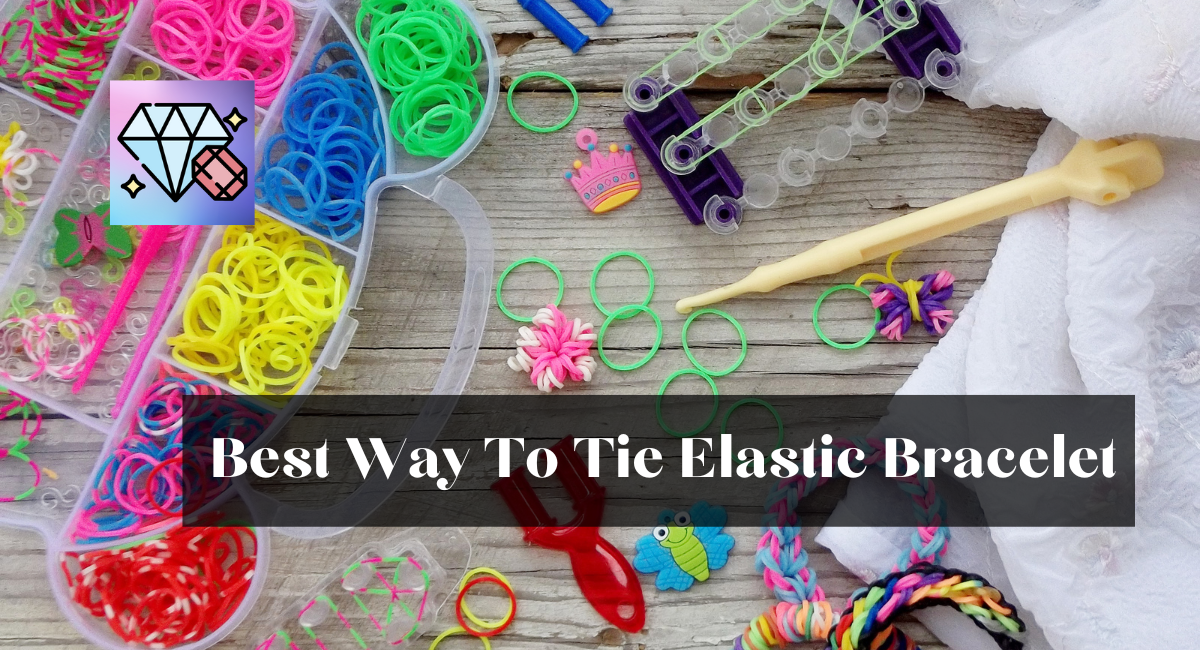It is important to tie an elastic bracelet tightly so that it can last through daily use without losing its comfort and flexibility. Whether you have made jewelry before or this is your first time, this article, will explain best way to tie elastic bracelet.
Best Way To Tie Elastic Bracelet
Tying an elastic bracelet is an easy task that can be done in a number of different ways, depending on your personal taste and the type of bracelet you have. This is a simple way to make a wrap bracelet:
Materials
- Elastic cord or stretch cord (usually clear or colored)
- Beads or charms for your bracelet
- Scissors
- Clasps or closures (optional)
Steps
1. Measure And Cut The Cord
Beginning with a length of elastic cord slightly longer than the circumference of your wrist, measure and trim the cord.
Add a few extra inches to ensure sufficient length for use. Incorporate the clasp into your measurements if you’re using one.
2. Prepare Your Beads
Prepare the beads by sliding the desired beads or trinkets onto the elastic cord in the desired order.
Consider creating a motif or alternating bead types to create a more engaging design. Leave a small amount of cord spare at each end to tie knots.
3. Tie The First Knot
Gather both ends of the elastic cord and secure a straightforward overhand knot.
Ensure the knot is secure but tight enough; you need some slack to manipulate the cord and modify the bracelet’s fit.
4. String Your Beads
Continue stringing your selected beads onto the cord until the bracelet reaches the desired length.
Use a bead design board or spread the pattern on a flat surface to plan the arrangement.
5. Tie The Second Knot
Once all the beads have been added, secure a second overhand knot with both ends of the cord. Make sure the tie is tight to secure the beads.
6. Test The Fit
Check to see if the band fits well by putting it on your wrist.
You can change the tightness by making the ties looser or tighter. It should be comfy, so make sure it’s not too tight.
7. Optional: Add glue
To reinforce the knots and prevent them from unraveling, apply a small drop of clear jewelry adhesive or super glue to each knot.
Avoid getting any adhesive on the beads or the string. Before donning the bracelet, allow the glue to dry completely.
8. Trim Excess Cord
After you have secured the knots and determined that the fit is satisfactory, use scissors to reduce any excess cord close to the knots. Ensure that you do not damage the bracelet or remove the knots themselves.
Before tying the knots, you can affix clasps to each end of the elastic cord if you prefer clasps for your bracelet. This will make it simpler to put on and remove the bracelet.
By following these easy but effective steps, you can tie your elastic band with confidence, knowing that it will look good and last through time and wear.
Tips
Here are some additional suggestions and factors to consider when creating elastic bracelets:
- Choose the Right Elastic Cord: Ensure that you choose an elastic cord that is suitable for your project. Consider the density, elasticity, and hue. Thicker cords are more resilient but may be more difficult to manipulate for tiny beads. Typically, clear or colored cords are used, but you can choose a color that complements the design of your beads.
- Use Quality Beads: Invest in Quality Beads Invest in beads or trinkets of high quality. Beads of inferior quality may have irregular holes or shatter more easily, reducing the bracelet’s overall durability.
- Secure Knots Properly: When tying knots, ensure they are firm enough to secure the beads but not so tight as to damage the cord. Stretch cord has some give, but excessive tension can cause it to break.
- Glue with Caution: If you use glue to secure the knots, use a small amount and be extremely cautious not to get any on the beads or the cord. A small trickle on the knot is sufficient. Some glues may not be suitable for certain types of crystals; if uncertain, test on a spare piece.
- Consider a Clasp: If you desire a snug fit, adding a clasp to your elastic bracelet can make it simpler to put on and take off. Various clasp types are available for jewelry creation, so select one that complements your design.
- Allow for Stretch: Remember that elastic cord stretches, so when measuring the circumference of your wrist for the bracelet, strive for a snug fit. It will expand upon insertion.
- Experiment with Designs: Be inventive when arranging your beads. Create one-of-a-kind and personalized designs by mixing bead sizes, hues, and textures. You can also add spacer beads or trinkets for added visual appeal.
- Knot Covers: Crimp beads, and bead closures can be used to conceal knots and provide a professional appearance. These components are available in various designs and can lend a decorative touch to your bracelet.
- Test for Durability: Before wearing your bracelet routinely, test its durability by gently stretching it. This will help identify any weak points or knots in the cord that require reinforcement.
- Practice Makes Perfect: If you are new to making elastic bracelets, practice on a few basic designs before attempting more complex ones. Getting the knack of tying secure knots and creating the ideal fit may take some practice.
Read More: What Is The Strongest Stretch Cord For Bracelets?

